
The Spanish Line (CTE) MS Guadalupe & Covadonga - 1953 to
1973
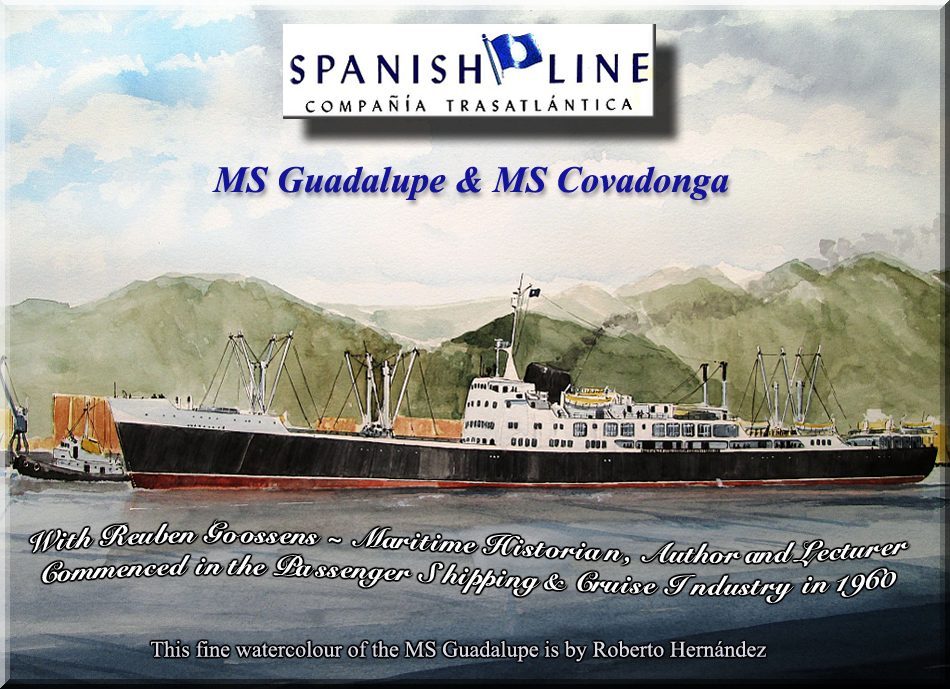
The
painting is of the MS Guadalupe by the artist as stated above
“The Spanish Line” became the premier
overseas Passenger Shipping Company of
At that time, the vessels they used was the wooden screw steamer “General Armero” being 716 tons and also a small wooden paddle steamer the “Botafuego” of just 143 tons.
In 1856 the brothers then returned to Alicante a port located south east of Spain and there they to set up a new shipping company, “Antonio Lopez Compania” and commenced a new passenger service from Alicante to Marseille with their three small Denny built ships; the “Madrid” 715 tons, “Alicante” 604 tons, and the “Marsella” 715 tons, and at Marseille the ship was able to connect with the newly opened railway lines there.
The company grew and prospered, but in 1881 the
company decided to move its base from
Antonio Lopez also had interests in certain
parts in Asia, he wished to expand a service to
However, The Spanish Line prospered over the years and operated many fine ships, including two well known ex Sitmar Line sisters the SS Begona (ex SS Castel Bianco) and the SS Montserrat (ex SS Castel Verde) as well as many fine passenger-cargo liners!
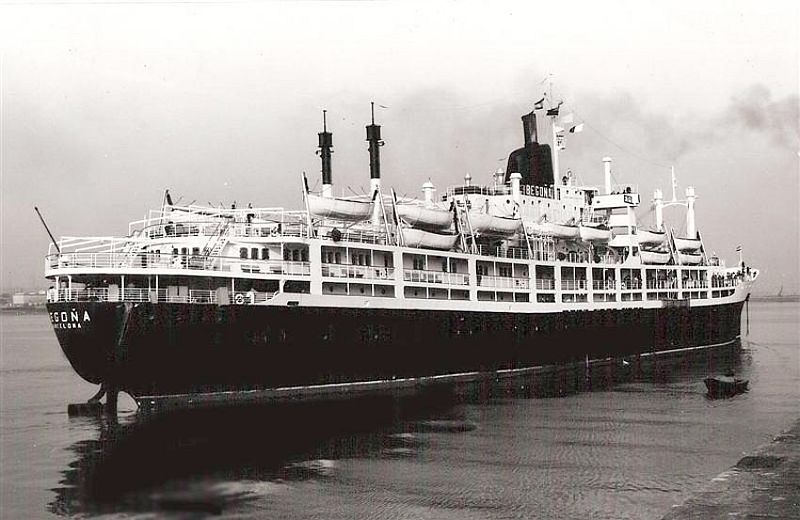
The very
popular liner, SS Begona
Both ships were laid down as cargo liners at
their respective builders as part of the “Monsasterio
Class” ordered by “Empresa Nacional Elcano”. The
first (1) ship of the pair was originally to be named;
“Monasterio de Guadalupe”, and the second (2) ship;
“Monasterio de la Rábida” but they were never given
those name.
The second (2) ship was constructed by; Cia
Euskalduna,
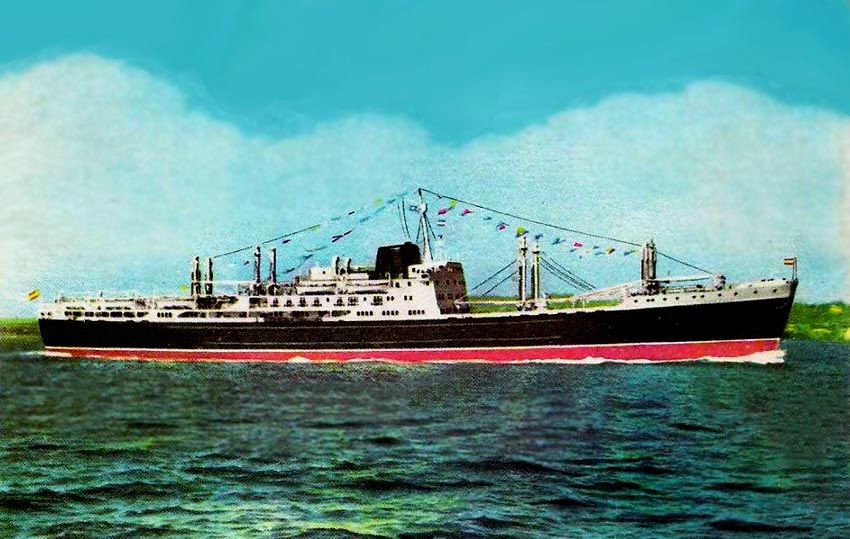
A postcard of the MS Covadonga and she is certainly a fine looking ship!
Take note of her after decks, *see the note below
Atop her bridge was a well designed shapely
tall mast with a traditional look-out close to the top, whilst
directly aft was a rather short but tapered black funnel.
On Promenade (Bridge) Deck along the side of
the ship, beside the four evenly paced half height windows, in
pairs of two (the Smoking Room), directly aft there were a series
of seven multi-paned windows, which were for the First Class
special cabins private glazed in veranda’s.
*If you will look carefully at the two ships on this page you will note that their aft decks are quiet different as are their lifeboat configurations, for the MS Covadonga aft decks were built up more than her sister ship the MS Guadalupe.
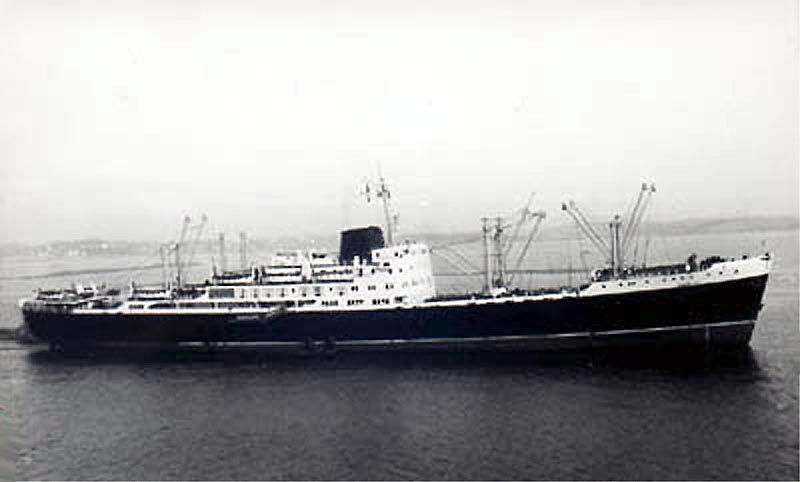
A Photograph of the MS Guadalupe, you will note her different style of aft decks
Of course because being passenger-cargo liners,
they had a large cargo capacity, and thus there were five holds
including some with insulated space. These holds were serviced by
four sets of king posts and their respective derricks.
MS Guadalupe departed for her maiden voyage on
May 21, 1953 from
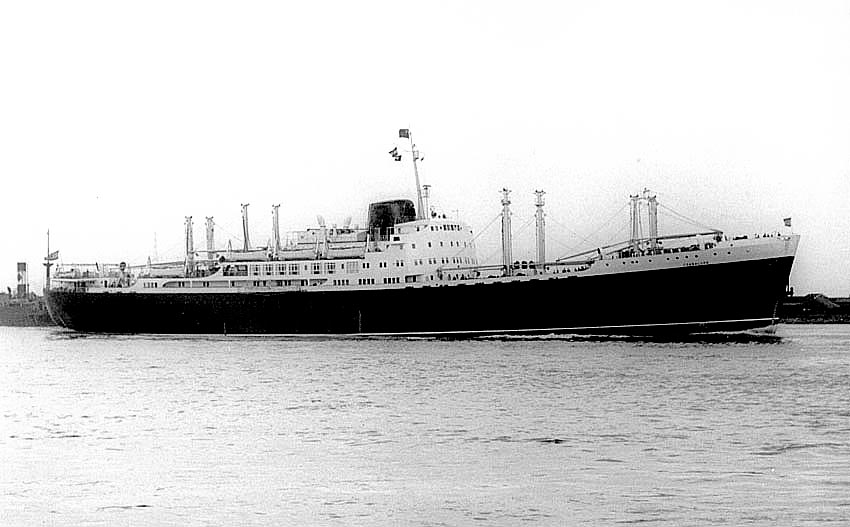
An excellent photographic postcard of the MS Guadalupe, a fine looking ship indeed!
(2) The second sister of the pair became the MS Covadonga and when she was completed she ran her speed trial late in April 1953, and was delivered to her owners early in May
MS Covadonga had a rather unusual maiden
voyage, which had nothing to do with the company’s regular
schedule, but her maiden voyage was more like a special cruise to
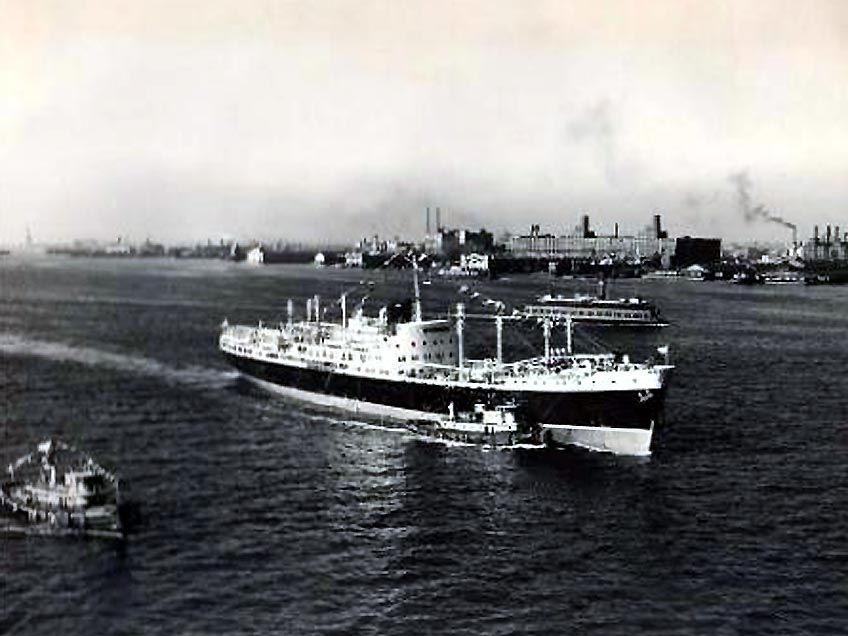
MS
Covadonga is seen arriving in
Photographer is unknown - Please see
photo notes at the bottom of the page
Topside fat forward are the Captain and other
officers accommodations, whilst far aft was the First Class Music
Salon and Bar.
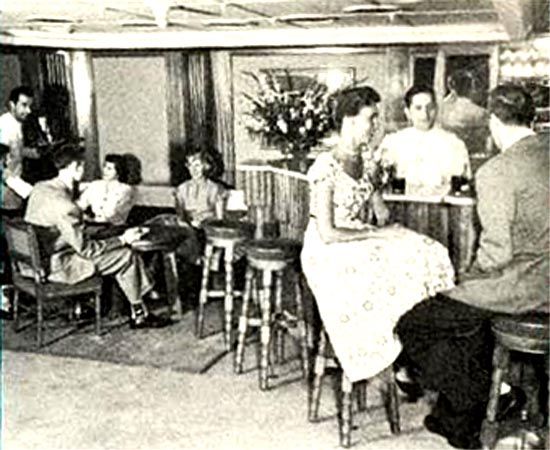
The Music Salon up on Boat Deck aft
Promenade (Bridge) Deck:
Forward on Promenade (Bridge) Deck by the main
stair well was the First Class Smoking Room, which was followed
by two exceptionally spacious Deluxe Suites one on the starboard
and the other on the portside.
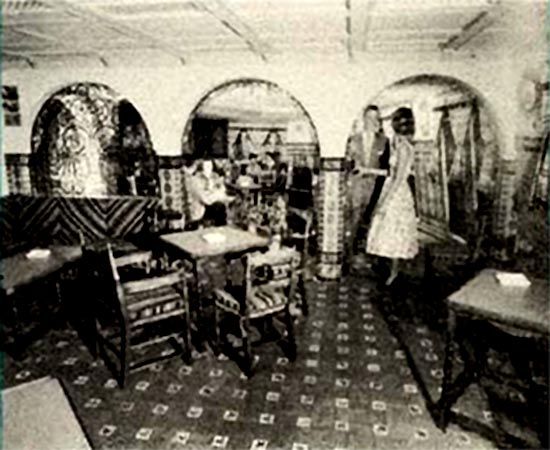
This is the First Class Smoking Room
Amidships there were six single cabins and eight twin bedded cabins each having a glazed in private veranda as well as private bathroom. Aft on this Deck was the location of the First Class Veranda.
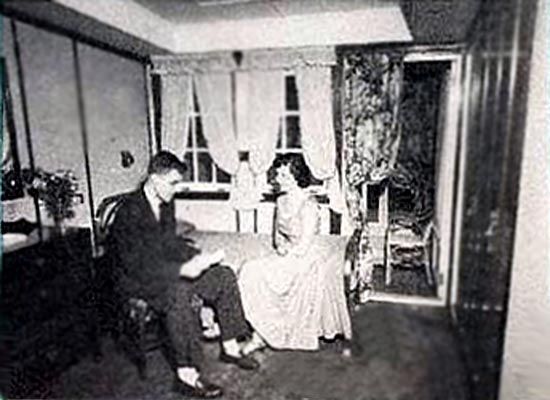
This is one
of those special twin bedded cabins with a private veranda
This can
just be seen in the rear of this photo
Upper (A) Deck:
Forward on this deck was the First Class Dining
Room, which was followed by a further twenty six First Class
cabins, for two, or three persons, the former having its own
private facilities. Far aft (only on the MS Guadalupe) was a
Cabin Class Lounge. Whilst on MS Covadonga there was a small Bar
overlooking the swimming pool just aft. Along the both sides of
this deck there was also some sheltered deck space ideal for a
morning walk.
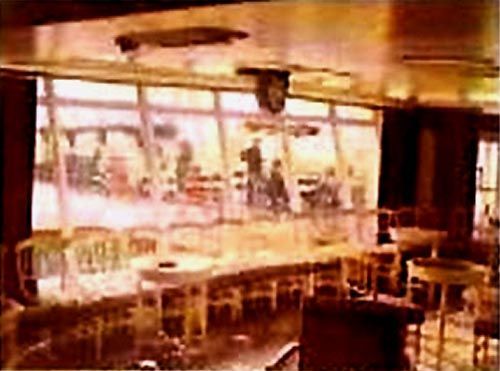
Cabin Class
Lounge on board the MS Guadalupe overlooking the Pool
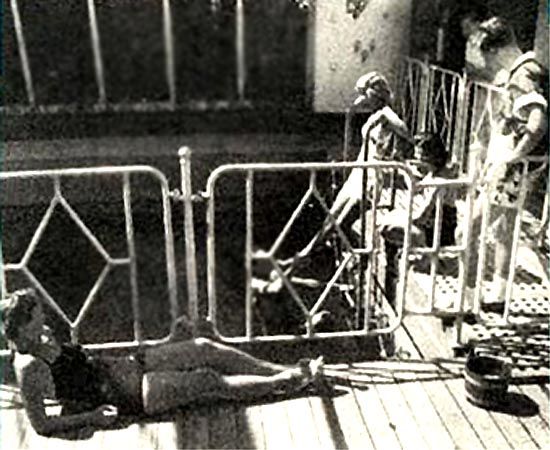
The ships
Swimming Pool
Main (B) Deck:
It was on this Deck where all of the Cabin
Class accommodations were located, and although there were some
two berth cabins, but the majority were four berth cabins, which
could also be sold for three persons. All Cabin Class
accommodations had shared facilities. However, on this deck there
was also the Cabin Class Lounge located further forward, and the
Cabin Class Dining Room towards the aft. Both ships had partial
air-conditioning.
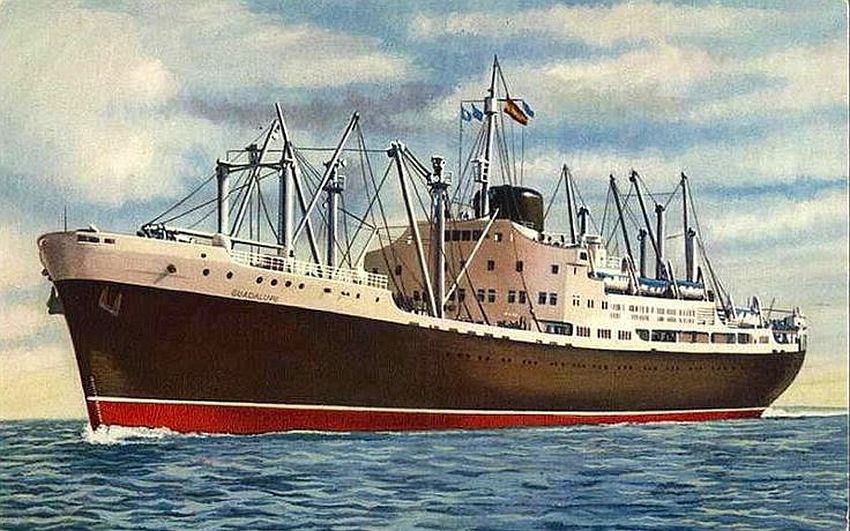
A great
company colour postcard of the first of the sisters completed MS
Guadalupe
Below you will find a deck plan covering the two ships, although each ship has a slight differentials when it came to the Cabin/Tourist Cass Lounge, etc, as noted above, and this is also shown on the deck plan, but in a rather confusing manner I must say.
The brochure containing the Deck Plan below is a smaller version, and in order to view a larger size you can either click on the plan, or brochure as marked, or use the link located below same and as new page will open with the larger version. Although a smaller sized image may appear at first, just click on it and it will enlarge to its full size.
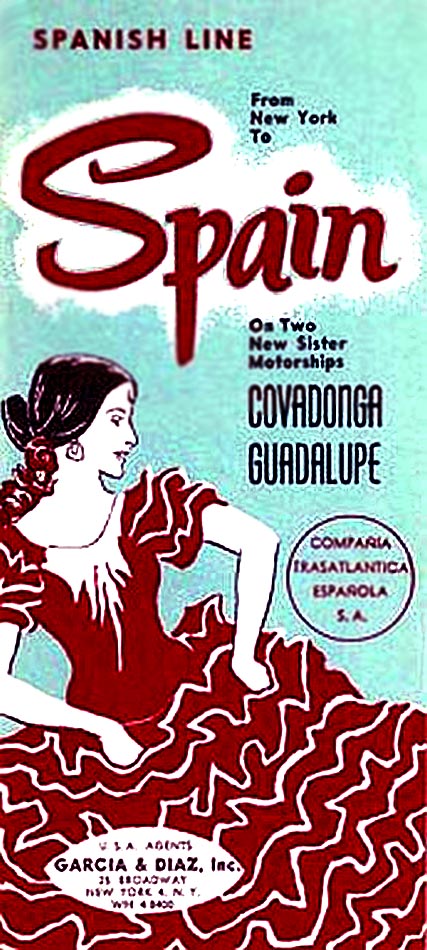
Brochure
cover that contains the deck plan
www.ssmaritime.com/CTE-Brochure-Lge.jpg
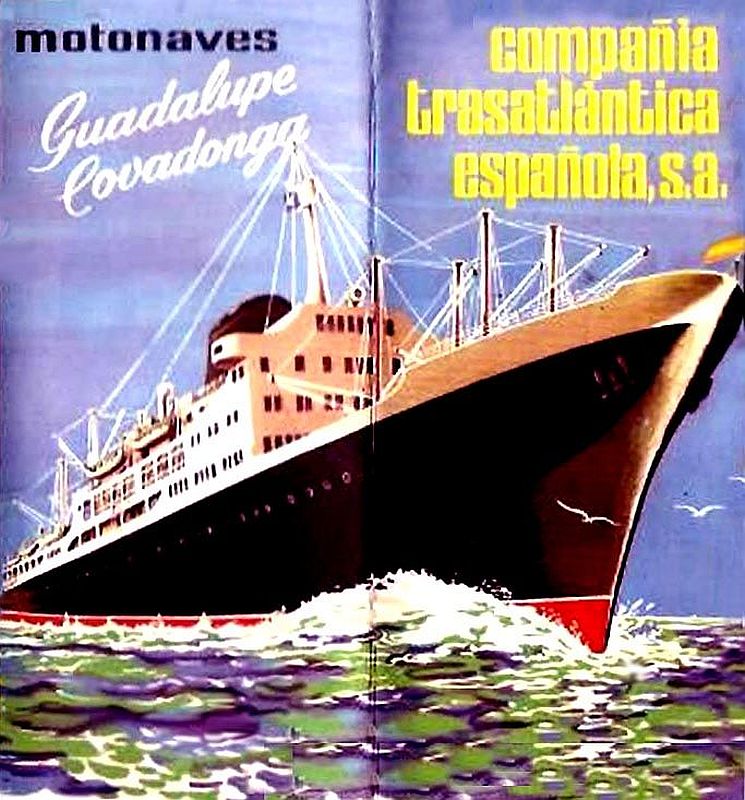
Here we see
yet another American based brochure promoting travel to
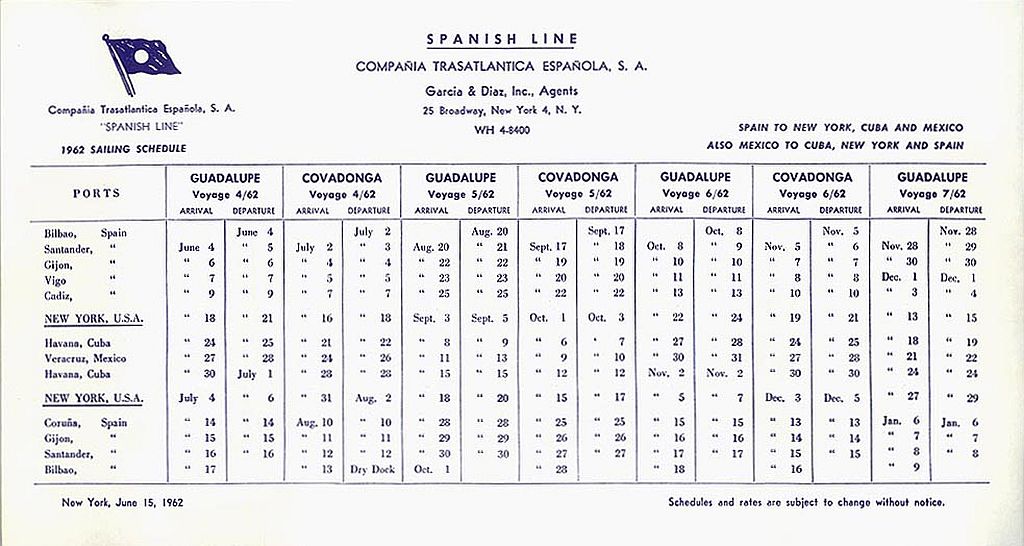
This 1962
sailing schedule, speaks for itself, more on details below
The MS Guadalupe and her sister ship the
Covadonga operated on the
1 … 1962 Schedule:
Bilbao, Santander, Gijón, Vigo, Cádiz, New York, Havana, Veracruz - New York, Coruña, Gijón, Santander, Bilbao.
2 … Although they did vary occasionally
and
The Map on the brochure shown above, which can
be enlarged, will give you some idea of the wonderful ports
visited in and around
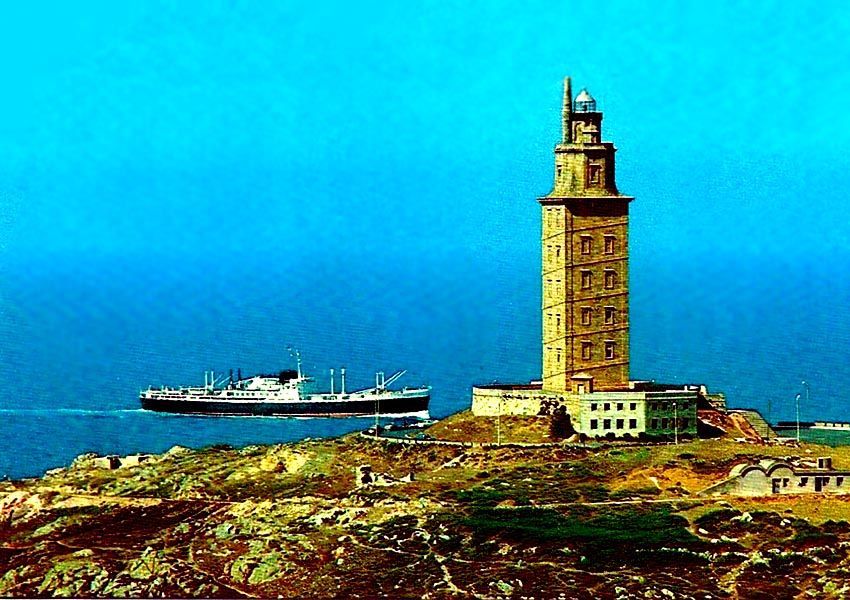
A fine
postcard of the MS Cavadonga arriving at Coruña passing the
famous “Tower de Hércules” seen on the mountain
However, as he years passed and suddenly the late 1960’s had arrived and the company had become well aware that the passenger trade, as well as regular cargo services was rapidly changing. Slowly passengers were beginning to travel by air, and the truth was that a new style of cargo handling service had arrived on the scene. By around 1970, the Spanish Line became aware that profits were slowly declining. However, the company continued to make a reasonable, be it a lesser amount then in the past on these ships, thus they decided to keep them going, even in these slowly declining days.
But sadly two years later things had come to the point where a decision had to be made if it was worth to continue operating these two ships for by now, passenger loading had fallen to very low loadings, as well as cargoes were disappearing to much larger ships that operated at much greater speeds and had superior handling equipment, etc., all this was reducing costs for all concerned, but the Spanish Line was now beginning to lose considerably.
Therefore in 1973, The Spanish Line decided, with a great degree of sadness, to sell MS Guadalupe and the Covadonga to local Spanish ship breakers and they were duly broken up.
It is noteworthy that these two fine Passenger-Cargo Liners were the very last ever to operate on this special service on a regular basis, and it was a great loss to all ports they visited so regularly, for the passengers would undertake excursions and spend good deal of money in each port, thus it was good for the local economy.
Specifications
(1) MS Guadalupe & (2) MS
Covadonga:
Ship Type:
Passenger-Cargo Liners.
Ship (1):
Built by:
Soc. Espanola de Const, Naval, at
Launched:
May 2, 1951 as the ‘Monasterio de Guadalupe’.
Registry
N°:
397.
Completed:
March 1953 & named ‘Gaudulupe’.
Maiden
Voyage:
May 21,
Ship (2);
Built by:
Cia Euskalduna,
Launched:
October 31, 1951 as the
‘Monasterio de la Rábida’.
Registry
N°:
400.
Completed:
May 1953 & named ‘Covadonga’.
Maiden
Voyage
Late May 1953 to
August 27, 1953 - Maiden
voyage to
Ships (1
& 2)
Tonnage:
10,226 GRT, 8,023 NRT, 8,500 DWT 14,800 Displacement.
Sold to:
1952 both ships were obtained by “Cia Transatlantica”.
Length:
487 ft - 148.5 m.
Beam:
62 ft - 18.92 m.
Draft:
26.3 ft - 7.61 m.
Propulsion:
Sulzer Diesels, 10 Cyl x 720 mm bore x 1,250 mm stroke, 7,300 HP.
Propellers:
One.
Speed:
16.5 knots service speed, 17.5 knots maximum.
Passenger
capacity:
(1) Total 353, 105 First Class & 248 in Cabin Class.
.
(2) Total 349; 105 in First Class and 244 in Cabin Class.
.
Partial air-conditioning.
Remembering Two Fine Ships of the …
(‘The Spanish Line”)
MS Guadalupe & MS Covadonga
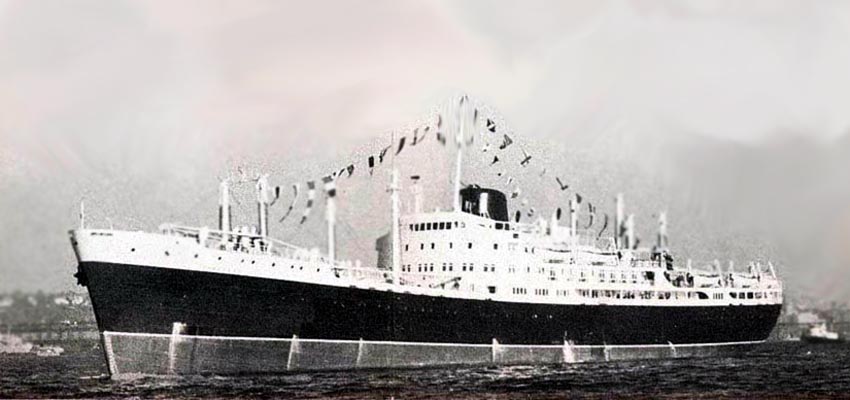
The MS
Guadalupe and sister MS Covadonga served the Spanish Line well
for a full 20 years
And they
certainly were greatly admired by both Americans as their
European passengers
Also
read about other Spanish Ships …
The last
of the ‘Ybarra’ Liners … MS
Cabo San Roque & Cabo San Vicente
‘Aznar
Lines’ Monte Style Liner … MS
Monte Ulia
Email the
author: rg@ssmaritime.com
If you do
email and ask me for them, you will receive no reply as you email
will be DELETED!
Use the Back
button on your browser or Close the Page to return to the
previous page
or go to our ssMaritime Main INDEX